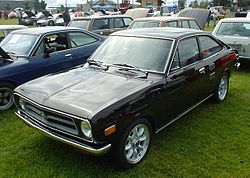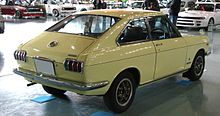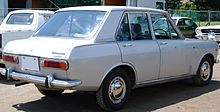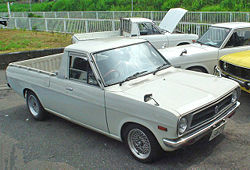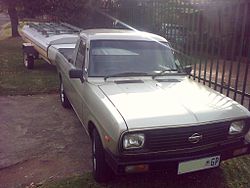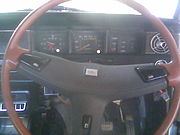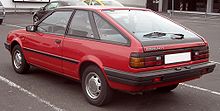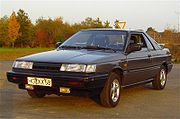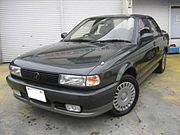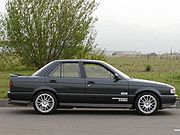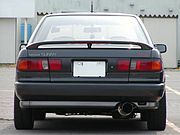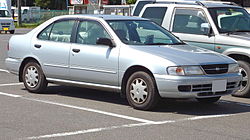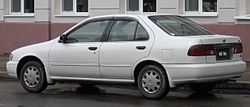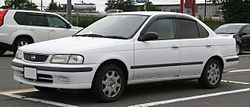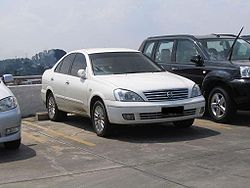- Nissan Sunny
-
For the Nissan Sunny sold in European markets during this period, see N14 Pulsar
The Nissan Sunny is a small car from Nissan. It was launched in 1966 as the Datsun 1000 and although production in Japan ended in 2004, it remains in production today for the African, American and Sri Lankan markets. In the US, the later models were known as the Nissan Sentra; in Mexico, the Sunny is known as the Nissan Tsuru.[1] The Sunny fitted neatly into the Nissan model line. It was larger than the supermini Nissan March (Micra) models, but not as big as the compact Bluebird models. The latest versions of the Sunny were larger than the early models, and may be considered compact cars. Earlier versions (through at least the B11 series) were subcompact cars. All Sunnys through the 1982 model year (except as noted below) used Nissan A engine motors.
Confusingly, the "Sunny" name has been used on other Nissan models not part of the Sunny (B-series) family, notably various export versions of the Nissan Pulsar model line.
B10 series
Datsun Sunny First generation (B10) 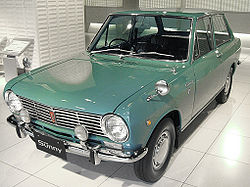
Also called Datsun 1000 Production 1966–1969 Body style 2/4-door sedan
2-door station wagon
2-door coupéLayout FR layout Engine 988 cc A10 OHV I4 Transmission 4-speed manual all-synchromesh.[2] Wheelbase 2280 mm (89.8 in) Length 3820 mm (150.4 in) Width 1445 mm (56.9 in) Height 1,295 mm (51 in) Curb weight 625-705 kg (1380-1556 lb) The first Datsun Sunny, exported as the Datsun 1000, was launched in September 1966, with two body styles, a two-door sedan (B10) and a van/station wagon (VB10). These were available in both a "Standard" and "Deluxe" version, featuring drum brakes, conventional leaf springs at the rear and wishbone type independent front end. The front end used a single transverse leaf spring. In Japan the car was sold at a dealership sales channel established just for the Sunny, called Nissan Saito Shop
The car featured a 4-cylinder in-line engine – the A10 – with a total displacement of 988 cc and a 4-speed gearbox. The 1968 model, introduced in October 1967 added to the lineup the four door sedan (B10) in both DeLuxe and Standard form. October 1968 saw the new 1969 models released with a new coupé (the KB10) added. Marketed as a "Sunny Coupé" in Japan, it was available in a wide variety of levels from "Standard", to "GL" (ostensibly Grand Luxe). The range of factory options and accessories was by this time vast. Total horsepower in the 1968 model was claimed to be 62 hp (46 kW) at 6000 rpm.
All of the other models got new grilles and larger tail lights, which now included reversing lights in the van/wagon model.
The only other country that seems to have received the coupé is Australia, where it was marketed as the "Datsun 1000 Coupé". It was well equipped, and was available only in the Deluxe level of trim. The Australian Deluxe model came standard with many inclusions that were available only as options in the Japanese model. The engine in the coupé had higher compression, a different Hitachi carburettor, and a dual outlet exhaust manifold. These changes increased its power output to 66 hp (49 kW); a 4 hp, or 6.5% increase over the lesser models. Unlike the sedans and wagons, the coupé was only ever made in right drive.
July 1969 saw the release of the slightly different (cosmetically) 1970 models which left the 1969 model run at only nine months. No additional models were added, and production ceased in December 1969, cutting the 1970 model run at only six months.
B20 series
The Sunny Truck debuted in October 1968 and was the light commercial truck variation of the B10 passenger models. It was based on the VB10 Van chassis, and is a body style which is correctly known as a (Japanese: Coupé Utility). This is known as a "Ute" in Australia and "Sunny Truck" in Japan.
Being a commercial model, these were only ever available in Standard trim. The equipment was basic, but this kept the price low.
The B20 used the same wheelbase and running gear of the Datsun 1000 VB10 van.
B110 series
Datsun Sunny B110 Series 
Manufacturer Nissan Also called Datsun 1200 Production 1970–1976 Class Subcompact Body style 2-door Coupé
2-door sedan
4-door sedan
4-door wagon
2-door wagonLayout FR layout Engine 1.2L A12
1.2L A12TTransmission 3-speed automatic
3-speed manual
4-speed manual
5-speed manualWheelbase 2300 mm (90 in.) Length 3830 mm (152 in.) Width 1495 mm (59.6 in.) Height 1390 mm (53.1 in.) Curb weight 700 kg (1640 lbs) The second-generation Sunny launched in 1970 and was also known as the Datsun 1200. This new model was slightly larger in all dimensions to match its market rival, the equally popular Toyota Corolla.
The Datsun 1200 featured MacPherson strut front suspension with optional disc brakes and an economical 1.2-liter A12-series engine. A 5-door station wagon was added to the Sunny range in addition to the 3-door wagon. In April 1970 a GX Grand Luxury trim with twin-carburetor engine was added for the Japan domestic market. In January 1972 a minor facelift occurred in the Japan market with a new hood, grille and other small modifications and equipment fitting. In August 1972, the GX-5 model was added in Japan, which improved on the GX by fitting a direct-fifth (non-overdrive) five-speed manual transmission. For the 1973 model year, USA models were re-specified with energy-absorbing bumpers, fire-resistant interiors and other government-mandated safety items.
The B110 made its racing debut at the Fuji 200 Mile race November 23, 1970 in the TS1300 class. In this class which was effectively a Toyota Corolla monopolistic state it was challenged by only one Nissan works car, but with beautiful victory for driver Suzuki Makoto.
In Australia and New Zealand, the Datsun 1200 was highly regarded for conversion to a 2WD rally car. The Datsun 1600 generally rated highest among entry-level Datsuns, and the 1200 a close second.[3]
The Datsun 1200 was the most fuel-efficient vehicle in the United States in 1973,[4] as rated by the government at 28.7 mpg-US (8.20 L/100 km; 34.5 mpg-imp) in overall driving pattern. It achieved 37.9 mpg-US (6.21 L/100 km; 45.5 mpg-imp) in highway driving.[5] At its United States introduction, it was the lowest price car at $1866. (Road & Track magazine, November 1970)
In Mexico, the Sunny B110 was marketed as the Nissan Sentra.
In South Africa, the B110 was sold through 1976. A pick up (bakkie) derivative, featuring a 1400 cc engine, was sold until 2008 when emissions laws forced the end of its production. Over 275,000 were sold to customers who appreciated the rugged rear-wheel drive design.[6]
In New Zealand, a special edition Datsun 1200 SSS 4-door sedan with twin side-draft Delorto 40mm carburetors and other racy features was marketed.
In Portugal, a special Datsun 1200 S1 2-door sedan was marketed.
In North America (US and Canada), there were an average of 44,000 Datsun 1200s sold each year for three model years, 1971-1973.
- Coupé total sales: 89,541
- 2-door sedan total sales: 43,761
Reference: Nissan model guide sheet
PB110 series
April 4, 1971, halfway through the model year, the Sunny Excellent (PB110 series) debuted for the Japan domestic market. It was based on the B110, but with new hood, fenders and grille, and featured a SOHC 1.4-litre Nissan L engine. The front overhang was extended 130 mm (5.1 in) and the wheelbase 40 mm (1.6 in). In Mexico this was marketed as the Sentra 1400.
At the Tokyo motor show, October 19, 1972, a Sunny Excellent with Nissan's two-rotor Wankel rotary engine was exhibited (Article on Datsun1200.com). Wheels magazine drove this car on the race track.
B120 series Sunny Truck
The B120 commercial truck debuted in February 1971, based on the B110 passenger car chassis. The B120 used the same wheelbase and running gear of the Datsun 1200 sedans, coupé and wagon models. Initially it used the same stainless steel grille as the 1200 sedan, and the rectangular gauges of the Standard model B110s. Both regular (B120) and long-bed (GB120) models were offered. After the 1200 car series ceased production the B120 continued. Interestingly, in certain markets the B120 was actually badged as 120Y, to correspond as part of the updated 120Y range. The B120 ute was sold in Australia until 1985. It was marketed in New Zealand during the 1980s in two trims: RoadStar and SportStar. This model was known as a bakkie in South Africa. It's capable of 49 mpg-US (4.8 L/100 km; 59 mpg-imp)).
In 1978, in the Japan market the B121 model replaced the B120, with the most notable change being a switch to a plastic grille of the type used by the B110 Coupé. Also notable was a change to upscale round instrumentation.
In November 1989, an updated B122 and GB122 (longbed) models replaced the B121. Prominent among changes was a switch from round headlights to rectangular ones (along with new grille to accommodate this change). However other significant changes included:
- front disc brakes
- catalytic converters
- NOx Conforming (emission controlled) models RB122 and RGB122 the A12 engine.
B140 series Bakkie
The Sunny Truck lived on in South Africa for a total of 37 years (launched there in 1971). The B140 variation, with 1.4-liter A14 engine, was manufactured up until 2008 by Nissan South Africa as the Nissan LDV 1400 (Light Delivery Vehicle). The 1400 Bakkie saw many changes in its long career. The main ones were a 5 speed manual gearbox, power assisted disc brakes, and a roof height extension to accommodate taller South Africans. A sport model of the 1400 Bakkie was marketed as the "Champ". This model had appropriate side striping, individual seats, a rev counter, and central handbrake. This vehicle had two popular local nicknames, either just plain "1400" (all South Africans know this) or "kanniedood" which translated from Afrikaans means "Cannot Die", a testament to its reliability. The 1400 Bakkie was replaced late in 2008 by the "NP200", a derivative of a Romanian Dacia passenger saloon (sold as a Renault Logan in the same market). A major departure for the "Nissan Bakkie" is that the new model is front wheel drive (FWD), whereas the original was rear wheel drive (RWD) - a major selling point of the vehicle in South Africa where it was the only RWD bakkie in its class for many years and where "RWD" adds a lot of ownership macho. A long standing marketing credo was "put the power where the load is" (similar wording).[7] The 1400 Bakkie was assembled by Nissan in Rosslyn, South Africa (Nissan).[8] Another assembly location for the model was the AYMESA plant in Quito, Ecuador which assembled it under the Datsun brand name as the 1200 PickUp.
B210 series
Datsun Sunny B210 Series 
Manufacturer Nissan Also called Datsun B-210, 120Y, 140Y, Sunny
Yue Loong 301[9]Production 1973–1983 Class Subcompact Body style 2-door Coupé
2-door sedan
4-door sedan
2-door panel van
2-door wagonLayout FR layout Engine 1.2L A12
1.3L A13
1.4L A14
1.4L L14
1.6L L16
1.6L L16TTransmission 3-speed automatic
3-, 4- or 5-speed manualWheelbase 2,340 mm (92.1 in) Length 3,950 mm (155.5 in)[10]
4,080 mm (160.6 in) (with US bumpers)Width 1,545 mm (60.8 in) Height 1,360 mm (53.5 in) Curb weight 2,000 lb (907 kg) Exported as the Datsun 120Y and Datsun B-210 (in North America), the third generation (1973–1978) Sunny was extremely popular as it debuted during the gas crisis of the 1970s. Six body styles were offered: the 4-door sedan, 2-door sedan, 2-door hatchback coupé, 2-door wagon, 4-door wagon and 2-door van. The coupé still retained fastback styling, but now featured a full hatchback door rather than the small trunk lid of the previous generation Sunny. The wagon and van were not offered in North America.
The Sunny continued to be the fuel-economy leader in North America and one of the least expensive cars available. This was in part due to the light metal; small A12 or A14 engine with OHV technology; and a very basic vinyl interior used in its construction. At the time, their body styles were popular with buyers - mainly the hatchback coupe as the sedans were considered by some to be less appealing. American B210s were the first Sunny's to have the larger 30 mph collision bumpers- due to the US's safety standards at the time. Other markets continued with the more tightly fit chrome bumpers.
The "Datsun Honeybee" and The "Datsun SSS" were limited edition B-210s; the Honeybee being released only in North America and the SSS in New Zealand and Australia. Both only featured minor aesthetic differences to the regular B-210. Nonetheless these models are now considered collector's items among Datsun enthusiasts.
Although regular production in Japan as well as sales in most countries ended with the 1978 model year, the B210 series continued to be produced by Nissan South Africa through 1980.
The 1978 B-210 (American model) with 5-speed transmission was rated by the United States Environmental Protection Agency at 50 mpg-US (4.7 L/100 km; 60 mpg-imp) highway fuel economy.
The 120Y was sharply criticized by magazines such as Wheels of Australia, which felt that it offered no true improvement on its predecessor, not surprising given that the B110 platform was carried over, but used a slightly revised A12 engine. Like some Nissans of this period, it tended to be overstyled.
The related Sunny Excellents continued as PB210 models, fitted with a 1.4-litre L14 engine. In 1976 Nissan changed the Sunny Excellent from a distinct vehicle model (PB210) to simply a trim-level option for the regular B210, now fitted with 1.6-liter L16 engine.
Road & Track was somewhat critical of the B-210 in their 1975 test[citation needed]. They criticized the "modest performance" of the "peppy" engine, but were impressed with its 27 mpg-US (8.7 L/100 km; 32 mpg-imp) fuel economy. B210 pricing started at US$2849 that year.
This chassis formed the basis for the S10 chassis on the Nissan Silvia.
US-market models were fitted with these A-series engines (years given are model years):
- 1974: A13 engine, 1.3 L (1288 cc) OHV I4
- 1975-1978: A14 engine, 1.4 L (1397 cc) OHV I4, various horsepower ratings from 65-85 hp
In most markets, the B210 line featured as the only engine option a re-designed A12 engine. However, in the South African market they also featured L14 and L16 engine options, as well as a special edition of B210 coupé badged as a 140Z and a 160Z. The 140Z and 160Z featured twin SU carburetors and a 5-speed transmission.
1974–1977 Datsun 120Y (B210) sedan (Australia)1974–1977 Datsun 120Y (B210) sedan (Australia)A highly modified "ground effect" 120Y fastback coupe is the fastest Datsun/Nissan in the world. Tom Burkland's "411 To Bonneville" holds the B/BFCC record at Bonneville from 1985 to the present day with a speed of 294.868mph. SCTA records
Appearance on Monster Garage
Monster Garage converted a 1975 B210 into the "Honey Bee Drifter". It was one of the surviving 42 cars from the television series sold at auction by Barrett-Jackson in 2008, with direct link to the auction lot description still available here.
B211 Series
Nissan Sunny(GL)-B211 is a rear wheel drive 4-door saloon and were manufactured from 1976 in Japan. The A12(new) 4-cylinder 1.2 L(1,171 cc) engine which was extremely smooth and durable made it a highly reliable car. The popularity of the car increased due to its fuel economy (12–18 km/Liter). The car was much similar to the B210(120 Y) car by its appearance, but there are several differences between two models. It had beige interior, fog lamps, chromium plated parts including buffers and rear windshield heater. B211 was equipped with a special catalytic converter called Nissan Anti-Pollution System(NAPS).The car came with a 4-speed manual gear box and the maximum power output was 68 PS(70 HP) at 6000 RPM. There are several sub models of B211 series which can be identified by its side badge.
1976 Nissan Sunny B211 Series Car - Front View (Sri Lanka)1976 Nissan Sunny B211 Series Car - Rear View (Sri Lanka)1976 Nissan Sunny B211 Series Car Dashboard (Sri Lanka)B310 series
Datsun Sunny B310 Series 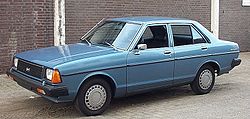

Manufacturer Nissan Also called Datsun Sunny
Datsun 210
Datsun 120Y/130Y/140Y/150Y
Yue Loong 302/303[11][12]Production 1978–1982 Class Subcompact Body style 2/4-door sedan
2-door coupé
3/5-door wagon/van
5-door wagon (fastback)
3-door panel vanLayout FR layout Engine 1,171 cc A12 I4
1,237 cc A12A I4
1.3 L A13 I4
1.4 L A14 I4
1.5 L A15 I4Transmission 3-speed automatic
4- or 5-speed manualWheelbase 2,340 mm (92.1 in) Length 4,190 mm (165.0 in) Width 1,580 mm (62.2 in) Height 1,365 mm (53.7 in) Curb weight 2,000 lb (907 kg) This is the last Sunny sold under the "Datsun" brand in Japan. The final rear-wheel-drive Sunny from model year 1978 to 1982 featured numerous variants, including a fastback station wagon as well as more squared-off, utilitarian models with three and five doors, a coupé, and two- and four-door sedans. These models appeared with Datsun 120Y, 130Y, 140Y and 150Y badges in some markets (depending on engine size) though Sunny was increasingly used for export, too. The North American version was marketed as the Datsun 210. The B310 was known for its high equipment levels and build quality at the time. It was available with the same A-series engines as its predecessor although the B210's optional 63 series 5-speed transmission was replaced with the smaller 60 series unit. The leaf spring rear suspension was discontinued and the live axle was now suspended using a coil spring four-link configuration. In 1980, the B310 was given a mild facelift, with a smoothed off front end, a grille with square headlamps, and a redesigned dashboard.
In North America, the only wagon offered was the fastback version. In Japan, this fastback wagon was a special model called the Sunny California, aimed at private buyers unlike the square-backed 3-and 5-door Sunny Van (although for the Japanese market these vans were always fully glazed and usually had a back seat) meant for the long-standing Japanese commercial wagon market. In most other markets the more traditional two-box wagon was offered, either alone or alongside the fastback, and some countries where "no rear side glass" was part of a legal definition of a "light truck" got panelled-in versions of the 3-door.
This model marked the first and only time the "Sunny" name was used in Australia. This chassis, along with the A10 chassis on the 160J/Violet/Stanza formed the basis for the S110 chassis on the Nissan Silvia.
In most markets, the A12 engine was the only, or most common engine offered. However B310s in various markets were fitted with the following A-series engines:
- A12 (1,171 cc, not offered in North America)
- A12A (1,237 cc)
- A13 (Short Deck Engine)
- A14
- A15
In North America, the Datsun 210 engine line ups were as follows:
- 1979 - A12A or A14
- 1980-1982 - A12A, A14 or A15
The special MPG model was a small-port A15 with 5-speed transmission and achieved 47 mpg-US (5.0 L/100 km; 56 mpg-imp) per US standards.
YLN 302/303
In Taiwan, Yue Loong continued building the B310 series until the 1990s as a lower priced alternative to more modern Sunnys. Originally introduced as the YLN 302, with SD or DX equipment (Standard, DeLuxe)[11] it underwent a facelift in 1981 in parallel with Nissan's Sunny, becoming the YLN 303. After another facelift (in 1989), it became the YLN 303S. The station wagon was also offered in Taiwan, as the YLN 303W. The Yue Loong-built B310s were only ever available with the 1.2-liter A12 engine.[12]
B11 series
Main Article: Nissan Sentra
The B11s were the first front-wheel-drive Sunnys—predating the same shift to front-wheel drive by their main Toyota Corolla rival—and were exported to the United States as the Nissan Sentra from the 1982 model year onwards.
The B11 series was regarded as one of Nissan's most modern ranges at the time, and was the first to abandon the Datsun name formally (though a small 'Datsun' still appeared on boot lids for the first two years). The wagon was known in its home market as the Nissan Sunny California. It was launched in late 1981 and continued into 1985. After the succeeding B12 had been presented, the B11 Sunny soldiered on as the "Sunny 130Y" as a lower cost alternative in certain export markets, including Malaysia; production continued well into the nineties.
The B11 was the first Mexico-market Sunny to be named Tsuru, a nameplate still in use there.
A further spin-off from the Sunny line was the (Japanese: Nissan Laurel Spirit), which was essentially a rebadged and better equipped Sunny sedan designed to capitalize on the premium image of the larger Laurel line.
Yet another spin-off from the Sunny line was the "Nissan Sunny Maxima", which was sold only in limited numbers in the United Kingdom, and was totally unrelated to the "Bluebird Maxima", which was simply just sold as the "Maxima" in the United States, and continues to be its own model spun off from the Bluebird range to this day. However, the "Sunny Maxima" line in the United Kingdom did not have any comparison to the "Bluebird Maxima" line in any shape or form. The "Sunny Maxima" line consisted only of upgrades such as a sunroof, enhanced exterior trim, only available with a 5-speed manual, chrome tailpipe, dual waveband radio meeting United Kingdom radio authority specifications, and deluxe carpeted floor mats, whereas the "Bluebird Maxima" line consisted of lengthened front end and overhang for first the L-series inline-6, then the VG in later generations as front wheel drive, sportier, crisper suspension for Fairlady Z like ride and handling, and a semi-luxury interior and features such as power seats, leather, automatic suspension control, and in some generations, a digital electronic instrument cluster, and has been known in the United States as the "4-door Fairlady Z", and the current generation now long spun off from the Bluebird line to this day as the "4-door Sports Car {4DSC}[13]
Nissan Vanette
A completely unrelated vehicle – albeit using a similar drivetrain to the previous B310 Sunny – the Sunny-Vanette, was introduced in 1979. This was exported to most markets as the Datsun C20 van. It later became the cabover Nissan Vanette.
In 1981, a vehicle not related to the Sunny, the cabover Vanette, was introduced. It was exported to most markets as the Datsun C20 van. Later, the name of this vehicle was changed to simply Nissan Vanette. Eventually, this van was replaced by the Mazda Bongo (also known as the E-series), which was sold under an OEM licensing deal as the Vanette.
Yet another vehicle, the Vanette Cargo, was sold under the Vanette name, in Europe as well. This van was based upon the Nissan Serena, and was unrelated to either the Sunny or the C20 van.
The Sunny 5-door station wagon was also introduced as a delivery van called the Nissan AD van, using the E15S, the E13S, and the CD17 diesel engine.
Appearances on Top Gear and Clarkson: Unleashed On Cars
In 1996, Jeremy Clarkson (of Top Gear fame) declared the Nissan Sunny to be the "worst car in the world, ever" and destroyed one by flinging it from a trebuchet pulled by a tractor. In 2003, on Top Gear, presenter Richard Hammond also proclaimed the Sunny to be the worst car ever, and had a Sunny incinerated by the exhaust fumes of a jet-powered funny car. Their main motivation being the dull design and driving experience of the Sunny making it a car of "no soul or character".
B12 series
From 1985, the B12 was not as widely exported, apart from the station wagon model. This line is characterized by its squared-off styling, which was very unfashionable by the mid-1980s[citation needed]. The angular styling was insisted upon by Nissan's design chief at the time and contributed to the automaker's increasingly poor sales of the period. A four-wheel-drive variant was introduced during this generation. It is also known as Sentra in some markets, and was sold in Mexico as the Nissan Hikari.
In October 1986, European markets saw the B11 Sunny replaced by a rebadged N13 Pulsar in hatchback and saloon form (the hatchback replacing the previous N12 Pulsar, which had been sold as the Cherry in this market). These were sold alongside the B12 Sunny estate and coupé. In some markets, such as Greece, the N13 Pulsar retained the "Cherry" nameplate.[12]
The B12 series Sentra remained the mainstream C-segment Nissan in North America throughout its run, although the models available dwindled over the years. At launch, sedans were available in two-door base or XE or 4-door XE or GXE models, along with two trim levels each of the coupe and FWD wagon, a short-overhang 3-door hatchback and an AWD wagon; by 1990 only one model each of the coupe, 4 door sedan and FWD wagon, plus two 2-door sedans (one with the same trim as the others and one extra-basic price leader) remained.
The "Sunny California"-style fastback was the only B12 wagon; the B11 "Sunny Van" continued in those markets where it was previously offered.
B13 series
The B13 was introduced in 1990 and retained many of the B12's ideas but in a more rounded, up-to-date body. It was particularly successful in the United States where the sports model two-door Sentra SE-R was marketed by Nissan of America as a latter-day BMW 2002. The car is still being made in Mexico, where is it sold as the Tsuru, for domestic and export markets (in Chile and Peru as Nissan V16), and is quite popular among cab drivers for its reliability and low maintenance costs. It was also part of the image of the former Mexico City mayor Andrés Manuel López Obrador, who drives a white Tsuru. In Taiwan, it is known as the Nissan 331.
The Nissan Sunny California wagon was discontinued and replaced with the Nissan Wingroad, a small family wagon based on the Nissan Sunny AD commercial delivery van.
Many units of the Nissan V16 in Chile are said to have lasted at least 500.000 or up to 700.000 km under worst conditions without opening the engine block for adjustments.
In Mexico, the Nissan Tsuru is still the best selling car in its category as it's much bigger and cheaper in maintenance than its direct competitors: the Volkswagen Pointer and the Chevrolet Chevy C2. The 2007 model is available in 2 trims: the GS 1 and GS 2. Both trims use a 1.6 liter 16-valve (ga16dne) engine producing 105 hp (78 kW) and can be equipped with an automatic gear-box and air-conditioning. A 2007 Nissan Tsuru GS1 costs approximately USD 9,500.
In Malaysia, known as Nissan Sentra Super Saloon with GA16DE fitted engine with two version (1st models & last models), it is widely used as a taxi in Genting Highlands, due to its engine durability and fuel efficiency in such conditions.[citation needed]
There are two versions of Nissan Sunny, the GTS generation 1 and the GTS generation 2. The GTS generation 1 consists of the glass headlights, generation 1 front bumper (with 2 projector lamps), side skirts, rear chin, sunny grille and the rear garnish. The GTS generation 2 consists of the plastic headlights, generation 2 front bumper (with 4 fog lamps), side skirts, rear bumper, sentra grille and the rear garnish. There are some differences in other parts like the rear garnish and the side skirts.
GTS ver 2GTSGen 1Gen 1B14 series
The B14 Sunny and Sentra appeared in 1994 and were produced until 1998, and featured four-wheel-drive variants. Other than Japan, this variant was produced in Karachi, Pakistan through a joint venture between Ghandhara Nissan and Nissan Japan till 2001 for the local and export markets.[14]
In this generation, the station wagon was supplied to Mazda under an OEM deal as the Familia Van. The Nissan Wingroad range appeared as a spin-off of the Sunny line in Japan, denoting a highly specified station wagon that replaced the Nissan Sunny California. Both the Mazda Familia and the Nissan Wingroad had different front and rear ends compared to the wagon that was exported.
Nissan Mexico sold versions of this as the Sentra with a 1.6 engine GA16DE from 1995 to 1997, GA16DNE from 1998 to 2000 and 2.0 engine (SR20DE) in the GSS version (top of the line).
Thailand and other selected Asian countries had this model of B14 from 1994 until 2000 with a few minor changes along the way. First minor change shows when the rear changes to split the red strip into two sides, next the face changes in a few years with a small ridge i the middle of the hood and a chromium decoration on the hood tip, finally the last minor change, the tail light style changes from two layers of white/red to be the three layers red/white/red. The two variants of engines is 1.5L (in the first generation) and 1.6L (available only after some minor changes).
All models were equipped with Multi-link Beam Suspension for the rear.
B15 series
The Sunny was produced up to the B15 series, from 1998 to 2007. For the 2005 model year in Japan, the Nissan Tiida took over this market, replacing the Sunny model line. In the United States, the Sentra continues with 1.8 and 2.5 litre engines, and carries on the Sunny lineage, though plans are to make the next Nissan Sentra based on something other than the discontinued Sunny chassis.
In Japan, the Sunny was offered with 1.3, 1.5, and 1.8 L petrol or 2.2 L diesel engines.
Also to be noted is that while earlier North American-market Nissan Sentras were very similar to their Japan-market B-series Nissan Sunny twins, the B15 Sentra (2000–2006) diverged greatly from the B15 Sunny. The Sentra B15 body looks similar to the aero-look B14 body, while the Sunny B15 body is return to the more traditional squared-off off three-box sedan design. In Japan the B15 was marketed as the Nissan Super Sunny.
The Wingroad station wagon and the badge engineered Mazda Familia Van (1.3, 1.5 and 1.8 L) continued to be spun off from the main Sunny range. A facelift for the Wingroad in 2002 gave it a new front end, though the rear was retained.
A new Wingroad wagon was released in 2005, based on the Tiida.
B17 series
For the first-generation Versa sedan, see Nissan Tiida.
The B17 (or L02B using Nissan's new code scheme) Sunny was unveiled at the 2010 Shanghai Auto Show. The new Sunny is powered by a 1.6-litre petrol that delivers around 80 kW (107 bhp) and 145 newton metres (107 lb·ft) of torque. The new model weighs less and has gained more legroom compared to its predecessor. The fuel economy is estimated to be 30 mpg-US (8 L/100 km; 36 mpg-imp) city and 38 mpg-US (6 L/100 km; 46 mpg-imp) highway with the CVT-equipped Sunny.[15]
The US-spec model was unveiled at the 2011 New York Auto Show as the second-generation Versa sedan. The new Versa sedan continues to compete with the likes of other entry-level sedans such as the Ford Fiesta, Chevrolet Aveo, Hyundai Accent, and Toyota Yaris. In the US prices start at US$10,990, higher spec models include Bluetooth, navigation system with 5-inch touch-screen display, Satellite Radio and an iPod®/USB interface.[16] It is said to be the cheapest car in the U.S.
The Thai-spec model will be released as the third-generation Almera on October 7, 2011 as a vehicle in the eco-car project of the Board of Investment promotion of Thailand (BOI). It will use the same 1.2-liter engine as the March/Micra, have a fuel consumption 5L/100km and have a 5-speed manual or CVT transmission.[citation needed]
The Japanese-spec model has been delayed due to the 2011 Tōhoku earthquake and tsunami.
Sunny name used with some Pulsar models
Main article: Nissan PulsarAlthough the Nissan Pulsar range (N-series family) was a separate model line with different heritage from Sunny (B-series family), for various reasons the Sunny name was—in some markets—applied to various Pulsar vehicles.
The Sunny name was used on the Pulsar N13 series in Europe from 1987, and was a successful model. In Malaysia and elsewhere the car known as the Nissan Sunny 130Y was a rebadged B11.
The N14 Pulsar was introduced in 1989 in Japan and in 1991 for Europe, badged as the Sunny. It introduced the 2 litre turbocharged 4-wheel drive GTI-R. The N14 came in five engine variants: 1.4, 1.6 and 2.0 L petrol (GTI), Diesel 2.0 L and the turbo 2.0 L SR20DET. It was replaced by the N15 Nissan Almera in 1996.
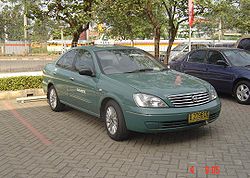 Nissan Sunny Neo 1.6 N16 Taxi in Indonesia
Nissan Sunny Neo 1.6 N16 Taxi in Indonesia
Although the N16 Pulsar did not spawn a Sunny range in Japan, the N16 Nissan Bluebird Sylphy was sold as the Sunny Neo in Thailand and Sunny in Hong Kong (In Hong Kong only the 1.5L QG15DE engine was imported by the dealer), Kenya, Singapore, Sri Lanka (where it is one of the best sellers), and the People's Republic of China (1.6L and 1.8L model, later the QR20DE equipped 2.0L model also available). The Sunny is produced for the Chinese market by the Dongfeng Motor Company, a joint venture with Nissan.
Also, the N16 series is sold in parts of Latin America as Nissan Almera. For 2007 model year, its platform changed to the Renault Samsung SM3 that is sold in northern Europe as Almera Classic. Also since 2007, the Renault Samsung SM3 is sold as a Nissan Sunny in the Middle East.[17]
References
- ^ "PAACE Automechanika". sema.org. http://www.sema.org/main/semaorghome.aspx?id=59848. Retrieved 2008-07-07.
- ^ "Autotest Datsun 1000 de luxe 988 cc0". Autocar. 130 (nbr3803): pages 22–26. 2 January 1969.
- ^ "Rallying Datsuns - Part 1 (Via Webarchive)". f2.rallysportnews.com.au. Archived from the original on 2006-02-13. http://web.archive.org/web/20060213174534/http://f2.rallysportnews.com.au/cms/A_103957/article.html. Retrieved 2008-07-07.
- ^ "We Test America's Most Economical Car". datsun1200.com. http://datsun1200.com/modules/nsections/index.php?op=viewarticle&artid=56. Retrieved 2008-07-07.
- ^ "datsun1200". datsun1200.com/modules. http://datsun1200.com/modules/myalbum/photo.php?lid=23. Retrieved 2008-07-07.
- ^ http://www.topcar.co.za/road-tests/tested/nissan-np200
- ^ "Tech Wiki - Datsun 1200 encyclopedia : Datsun 1200 Club". Datsun1200.com. 2010-07-07. http://datsun1200.com/modules/nsections/index.php?op=viewarticle&artid=83. Retrieved 2010-07-25.
- ^ "Fiat. Fiat In South Africa". Car-cat.com. http://car-cat.com/firm-1379.html. Retrieved 2010-07-25.
- ^ (in Italian) Quattroruote: Tutte le Auto del Mondo 77/78. Milano: Editoriale Domus S.p.A. 1977. pp. 554–556.
- ^ "Autotest: Datsun 120Y 4-door Latest small car from major Japanese manufacturer. Excellent performance and economy, good handling. But bouncy ride, poor brakes (except handbrake) and cramped back seat for normal passengers. Remarkably well equipped and good value for money". Autocar. 141 (nbr4065): pages Datsun supplement 10–16. 21 September 1974.
- ^ a b YLN 302DX/302SD 1200cc (catalog). Yue Loong Motor Co. http://storm.oldcarmanualproject.com/yln302.htm. Retrieved 2011-03-04.
- ^ a b c Mastrostefano, Raffaele, ed (1990) (in Italian). Quattroruote: Tutte le Auto del Mondo 1990. Milano: Editoriale Domus S.p.A. p. 1188.
- ^ [1][dead link]
- ^ "Nissan. Nissan In Pakistan". Car-cat.com. http://car-cat.com/firm-868.html. Retrieved 2010-07-25.
- ^ Anita Lienert (2011-04-20). "2012 Nissan Versa Sedan Debuts: 2011 New York Auto Show". InsideLine. http://www.insideline.com/nissan/versa/2012/2012-nissan-versa-sedan-debuts-2011-new-york-auto-show.html.
- ^ Car Advice, 2012 Nissan Tiida Unveiled in New York.
- ^ "Nissan Sunny Ultimate Car Buyer Guide". drivearabia.com. http://www.drivearabia.com/ultimatecarbuyerguide/usedcarspage3.php/3/8/. Retrieved 2008-07-07.
External links
- Nissan Sunny Owners Club - The Definitive Sunny Owners Club
- The Datsun 1200 Encyclopedia - focusing on B110 Series, but has information on all rear-wheel-drive Sunnys
- Nissan Sunny @ Imcdb
- RatDat.com - paint colors, sales brochures, and model names
- Sunnyclub.ru - the All-Russia club Nissan Sunny
Nissan Motor Company Vehicles Current370Z • Advan • Altima • Aprio • Armada • Atlas • Bluebird • Bluebird Sylphy • Cabstar • Caravan • Civilian • Clipper • Cube • Dualis • Elgrand • Frontier • Freeson • Fuga • GT-R • Juke • Lafesta • Leaf • Livina Geniss • Maxima • March • Murano • Moco • Navara • Note • NV200 • NV400 • Otti • Paladin • Pathfinder • Patrol • Qashqai • Quest • Rogue • Safari • Sentra • Serena • Skyline • Teana • Tiida • Titan • Urvan • Versa • Wingroad • X-Trail • XterraPastDC-3 • 100NX • 1200 • 310 • 180SX • 200SX • B-210 • 240SX • 240Z • 280ZX • 300C • 300ZX • 350Z • 510 • 810 • Almera • Almera Tino • Altra (EV) • Avenir • Auster • Bassara • Be-1 • Caball • Cablight • Cedric • Cefiro • Cherry • Cima • Crew • Datsun Truck • Echo • Expert • Fairlady • Figaro • Gazelle • Gloria • Hardbody Truck • Hypermini • Homy • Interstar • Junior • Largo • Laurel • Leopard • Liberty • Mistral • Multi • NX • Pao • Pintara • Pino • Platina • Prairie • Presage • Presea • Primera • President • Pulsar • Pulsar GTI-R • R390 GT1 • R'nessa • Rasheen • Roadster-Road Star • S-Cargo • Saurus • Saurus Jr • Silvia • Sileighty • Skyline GT-R • Stanza • Stagea • Sunny • Terrano • Terrano II • Vanette • VioletConcept126X • 216X • 270X • 300 Bambu • 315-a • AA-X • Actic • AD-1 • AD-2 • AL-X • Alpha T • Amenio • AQ-X • AP-X • ARC-X • AXY • AZEAL • Bevel • Boga • C-Note • Chapeau • Chappo • Cocoon • CQ-X • Crossbow • CUE-X • Cypact • Duad • Dunehawk • Effis • ESV • Evalia • EV Guide II • EV Truck • FEV • FEV-II • Foria • Forum • Fusion • Gobi • GR-1 • GR-2 • GT-R • ideo • Intima • Jikoo • Judo • Jura • Kino • KYXX • Land Glider • LEAF • LUC-2 • MID4 • Mixim • mm.e • Moco • Nails • NCS • NEO-X • NRV-II • NX-21 • NV2500 • Pivo • Pivo 2 • Qazana • Redigo • Round Box • Serenity • Sport Concept • Stylish VI • Terranaut • Tone • Townpod • Trailrunner • TRI-X • URGE • UV-X • XIX • XVL • Yanya • ZarootEngines GRX-3 • UD12 • VRT35Marques Nissan • InfinitiSubsidiaries
and divisionsSee also ATTESA • Datsun • HICAS • Prince • Renault-Nissan Alliance • Nissan Shatai • UD Nissan Diesel • VVL • VVEL • dCi
 Category ·
Category ·  Commons
CommonsNissan car timeline, European market, 1980s–present Type 1980s 1990s 2000s 2010s 0 1 2 3 4 5 6 7 8 9 0 1 2 3 4 5 6 7 8 9 0 1 2 3 4 5 6 7 8 9 0 1 Supermini Micra K10 Micra K11 Micra K12 Micra K13 Small family car Cherry N10 Cherry N12 Sunny B310 Sunny B11 Sunny N13 Sunny N14 Almera N15 Almera N16 Tiida C11 Large family car Stanza T11 Bluebird 910 Bluebird U11 Bluebird T12/T72 Primera P10 Primera P11 Primera P12 Executive car Laurel C31 Laurel C32 Maxima J30 Maxima QX A32 Maxima QX A33 Teana J31 Teana J32 Coupé Silvia S110 Silvia S12 200SX S13 200SX S14 Sports car 280ZX 300ZX Z31 300ZX Z32 350Z Z33 Mini MPV Note Compact MPV Prairie M10 Prairie M11 Almera Tino Large MPV Serena C23 Serena C24 Serena C25 Mini SUV Juke Crossover SUV Qashqai Qashqai+2 X-Trail T30 X-Trail T31 Murano Z50 Murano Z51 Terrano WD21 Pathfinder R50 Pathfinder R51 Off-roader Terrano II Patrol 160 Patrol Y60 Patrol Y61 Patrol Y62 Nissan road car timeline, United States and Canadian markets, 1980s–present Type 1980s 1990s 2000s 2010s 0 1 2 3 4 5 6 7 8 9 0 1 2 3 4 5 6 7 8 9 0 1 2 3 4 5 6 7 8 9 0 1 2 Subcompact Micra 210 Sentra Sentra Sentra Sentra Versa Versa Compact 310 Sentra Sentra 510 Stanza Stanza Stanza Altima Altima Leaf 810 Maxima Maxima Mid-size Altima Altima Maxima Maxima Maxima Maxima Full-size Maxima Sport compact Pulsar NX Pulsar NX NX 200SX 200SX 200SX 240SX 240SX Sports 280ZX 300ZX 300ZX 350Z 370Z GT-R (R35) Categories:- Nissan vehicles
- Vehicles introduced in 1966
- Rear wheel drive vehicles
- Vehicles with Wankel engines
Wikimedia Foundation. 2010.

